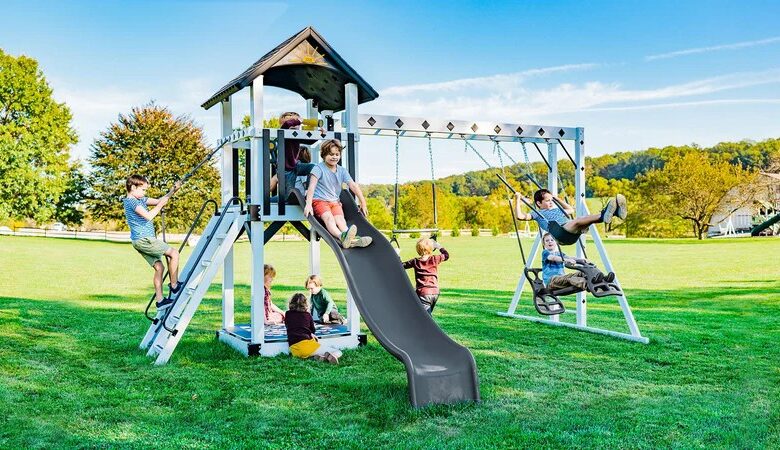The Complete Buyer’s Guide to Swing Sets: Styles, Materials, and Safety Tips

Swing sets have long been a staple of childhood fun, encouraging outdoor play, imagination, and physical development. Whether you’re outfitting a backyard for the first time or replacing an aging setup, buying the right swing set can be more complex than it appears. With so many styles, materials, and safety features available, it’s essential to make an informed decision that balances fun, durability, and peace of mind.
This comprehensive guide will help you navigate the world of swing sets, covering everything from popular designs and construction materials to installation options and essential safety tips.
1. Why Invest in a Swing Set?
Before diving into the options, it helps to understand why swing sets are such a worthwhile investment:
- Physical development: They help improve strength, coordination, and balance.
- Social skills: Multi-child swing sets promote sharing and cooperative play.
- Screen-free time: Outdoor play encourages children to disconnect from screens and enjoy nature.
- Convenience: A backyard swing set means hours of entertainment just steps from home.
2. Styles of Swing Sets
Swing sets come in a wide range of styles, each catering to different ages, play preferences, and yard sizes.
Classic A-Frame Swings
Simple and budget-friendly, A-frame swing sets usually include two swings and may offer a trapeze bar or glider. These sets are ideal for smaller spaces or younger children.
Pros:
- Easy to assemble
- Lower cost
- Great for toddlers and preschoolers
Cons:
- Limited play features
- Often outgrown quickly
Multi-Activity Playsets
These are swing sets on steroids. In addition to swings, they include slides, climbing walls, lookout towers, monkey bars, and even picnic tables.
Pros:
- All-in-one playground experience
- Suitable for multiple children
- Encourages imaginative play
Cons:
- Higher price point
- Requires more yard space
- More complex installation
Modular and Custom Swing Sets
For families with evolving needs or long-term plans, modular swing sets can be customized over time with additional components.
Pros:
- Expandable
- Tailored to your child’s age and interests
- Long-term usability
Cons:
- More expensive upfront
- May require professional installation
3. Choosing the Right Material
Material is one of the most critical factors when buying a swing set—it affects cost, durability, maintenance, and aesthetics.
Wood
Popular Choices: Cedar, Redwood, Pine
Wooden swing sets are prized for their natural appearance and strength.
Pros:
- Attractive and blends with landscaping
- Naturally resists insects and rot (especially cedar and redwood)
- Sturdy and stable
Cons:
- Requires annual maintenance (sealing, checking for splinters)
- Can warp or crack over time
- Heavier and more difficult to relocate
Metal
Popular Choices: Powder-coated steel, galvanized steel
Metal swing sets are often more affordable and easier to clean.
Pros:
- Weather-resistant with proper coating
- Lighter and easier to assemble
- Budget-friendly
Cons:
- May rust if the coating wears off
- Can get hot in the sun
- Typically less customizable
Plastic
Mostly used for toddler swing sets, plastic is lightweight and safe for younger children.
Pros:
- No sharp edges or splinters
- Lightweight and portable
- Low maintenance
Cons:
- Less durable for older kids
- Can fade and crack over time
- Not ideal for long-term use
4. Key Features to Look For
Not all swing sets are created equal. Look for these must-have features to ensure you’re getting the best value and functionality:
Adjustable Chains
Ensure the swing chains can be adjusted as your child grows. Bonus points if they’re coated in rubber or plastic for hand protection.
Anchoring System
A good swing set should include stakes, ground screws, or concrete mounts to keep it stable and safe during active play.
Expansion Potential
Look for sets that allow you to add slides, monkey bars, or rope ladders in the future.
Weather Resistance
Make sure the materials are treated to withstand UV rays, moisture, and corrosion.
5. Swing Set Safety Tips
Safety is paramount when it comes to swing sets. Here’s what to consider to minimize injury risks:
Age Appropriateness
Choose a set designed for your child’s age range. Toddler swings, for example, have full bucket seats and higher back support, while older kids benefit from open belt swings.
Soft Landing Zones
Install the swing set over a soft surface like rubber mulch, wood chips, or playground-grade sand. Avoid hard surfaces like concrete or asphalt.
Regular Inspections
Check the swing set regularly for:
- Loose bolts or screws
- Cracked or rusted parts
- Splintering wood
- Frayed ropes or damaged chains
Supervision
Always supervise young children and teach them proper swing etiquette, such as not walking in front of moving swings and using equipment properly.
Follow Weight Limits
Respect manufacturer guidelines on maximum weight per swing or play feature to prevent structural damage or injury.
6. Installation: DIY or Professional?
Some swing sets are simple enough for a weekend DIY project, while others may require professional help.
DIY Installation
- Pros: Saves money, satisfying project
- Cons: Time-consuming, may need special tools
Professional Installation
- Pros: Fast, safe, and accurate assembly
- Cons: Added cost (typically $200–$600, depending on complexity)
If you choose DIY, follow the instruction manual meticulously and never skip the anchoring step.
7. Budgeting for a Swing Set
Swing sets vary dramatically in price, from $100 to over $5,000.
| Swing Set Type | Price Range |
| Toddler Sets | $100–$300 |
| Basic Metal Sets | $150–$500 |
| Wooden Multi-Play Sets | $800–$2,500 |
| Customizable/Multi-Level Sets | $2,500–$5,000+ |
Consider long-term value, such as durability, expansion options, and resale potential, when setting your budget.
8. Final Tips Before You Buy
Before making your purchase, consider the following:
- Measure Your Yard: Leave 6 feet of clearance on all sides for safe play.
- Check HOA Rules: Some communities restrict swing set size or placement.
- Think Long-Term: Choose a set that your kids can grow into rather than out of.
- Read Reviews: Real-world feedback can reveal durability, ease of assembly, and customer service quality.
Conclusion
Swing sets provide countless hours of entertainment, exercise, and joy for children. But buying the right one takes careful planning. By understanding the various styles, materials, safety features, and installation options, you can find the perfect swing set for your family’s needs.
Whether you’re a first-time buyer or upgrading an old favorite, this guide will help you make a confident, informed decision. After all, there’s nothing quite like the sound of children’s laughter echoing from the backyard swing set on a sunny afternoon.




